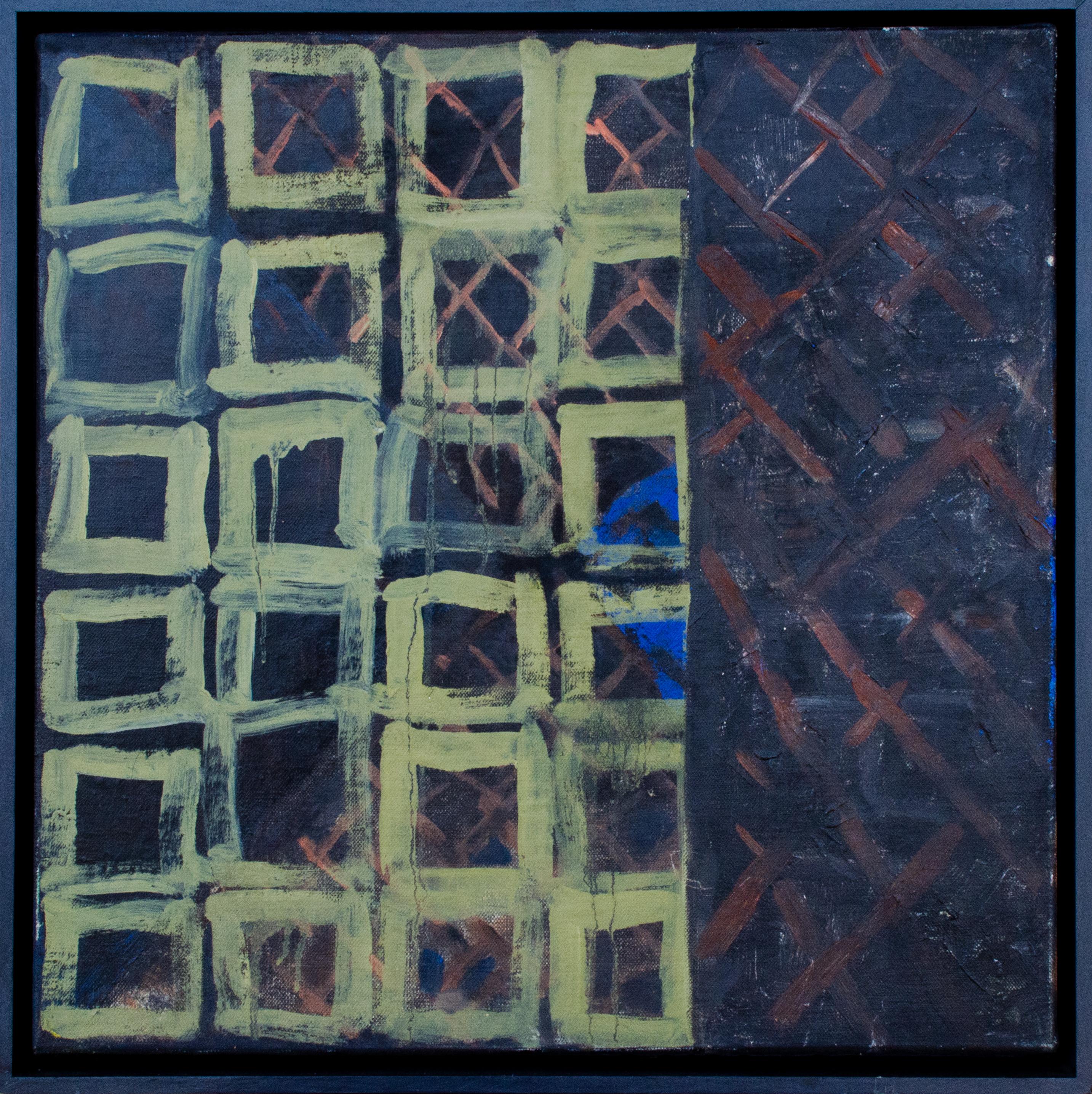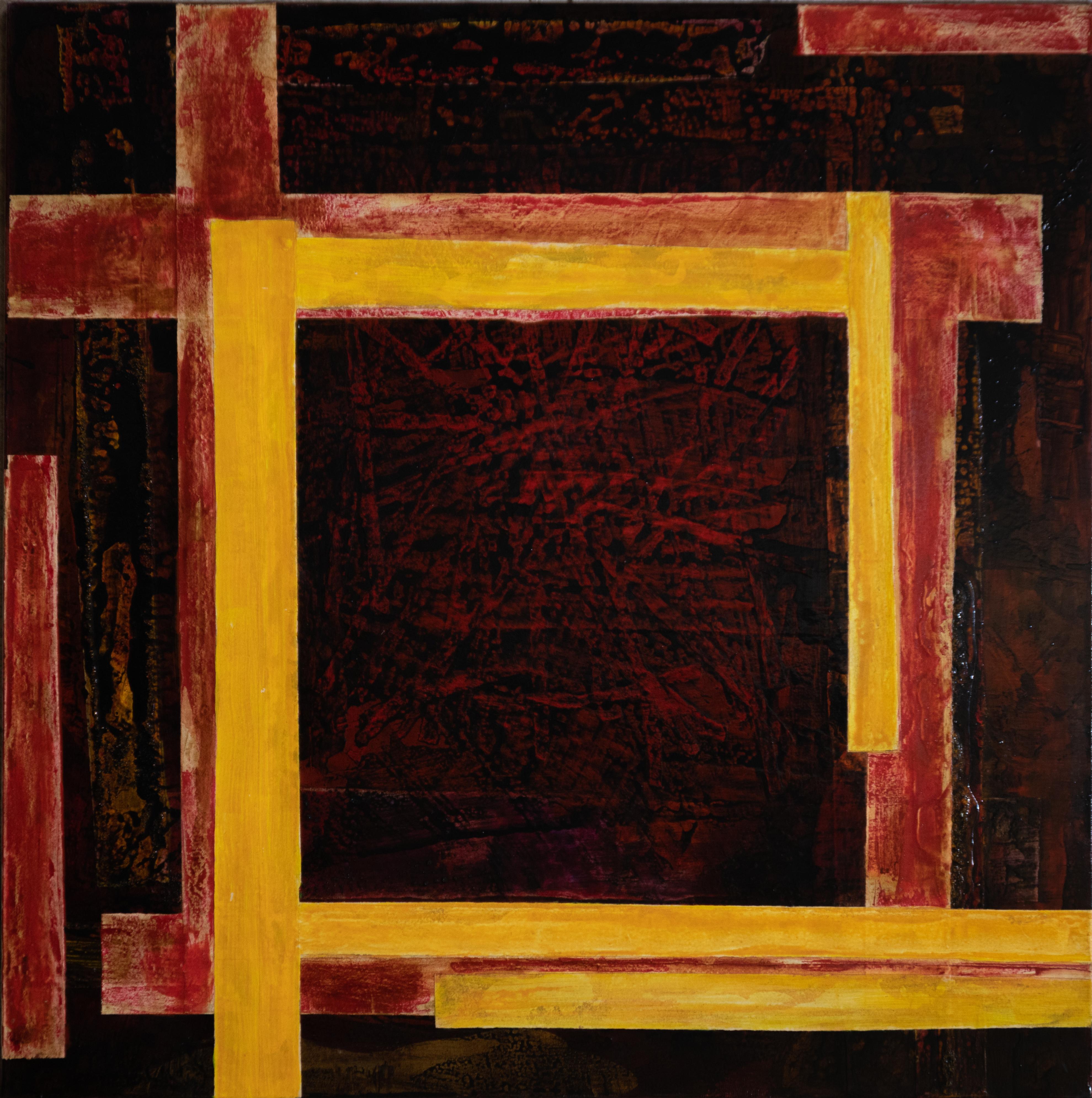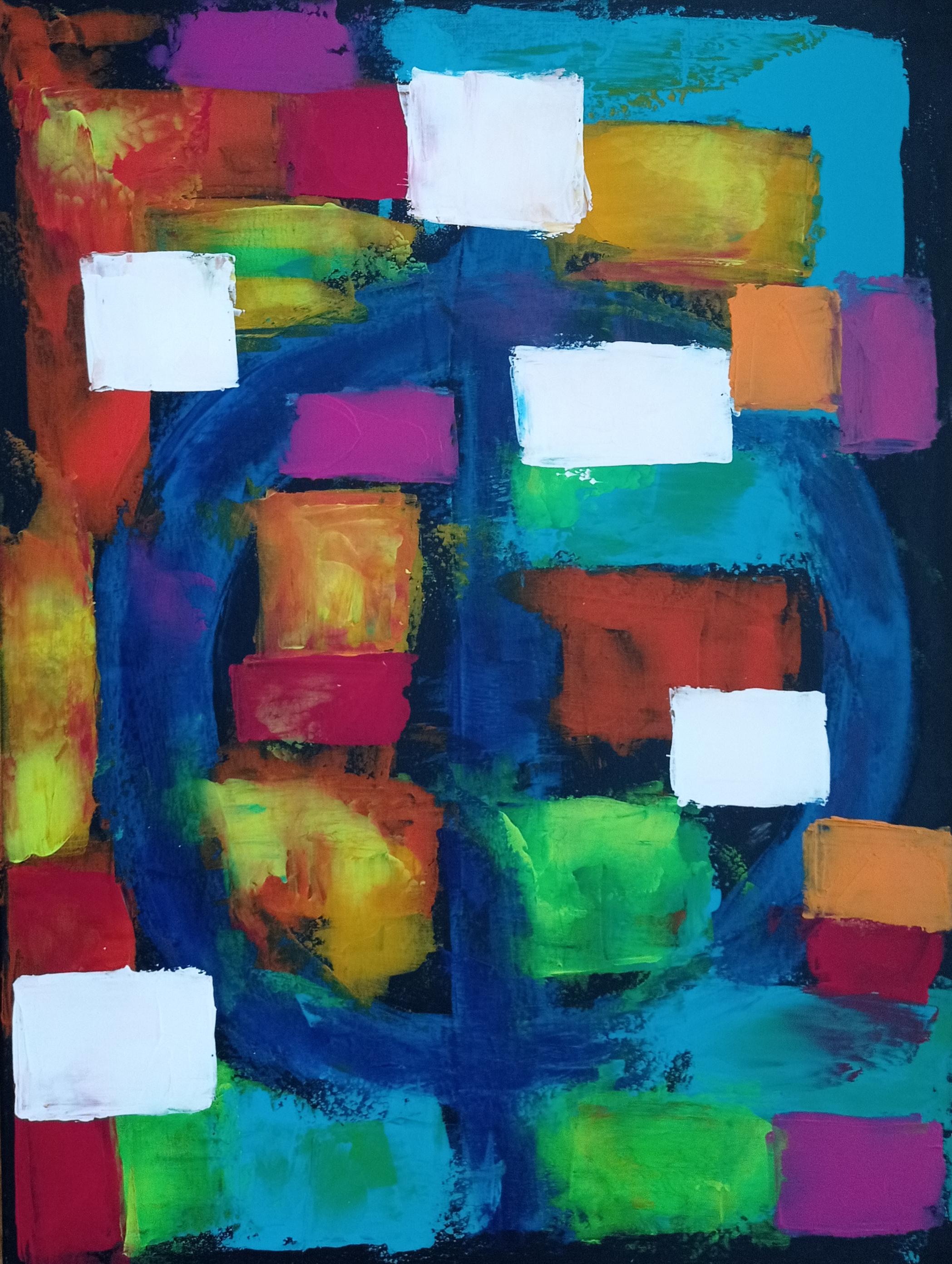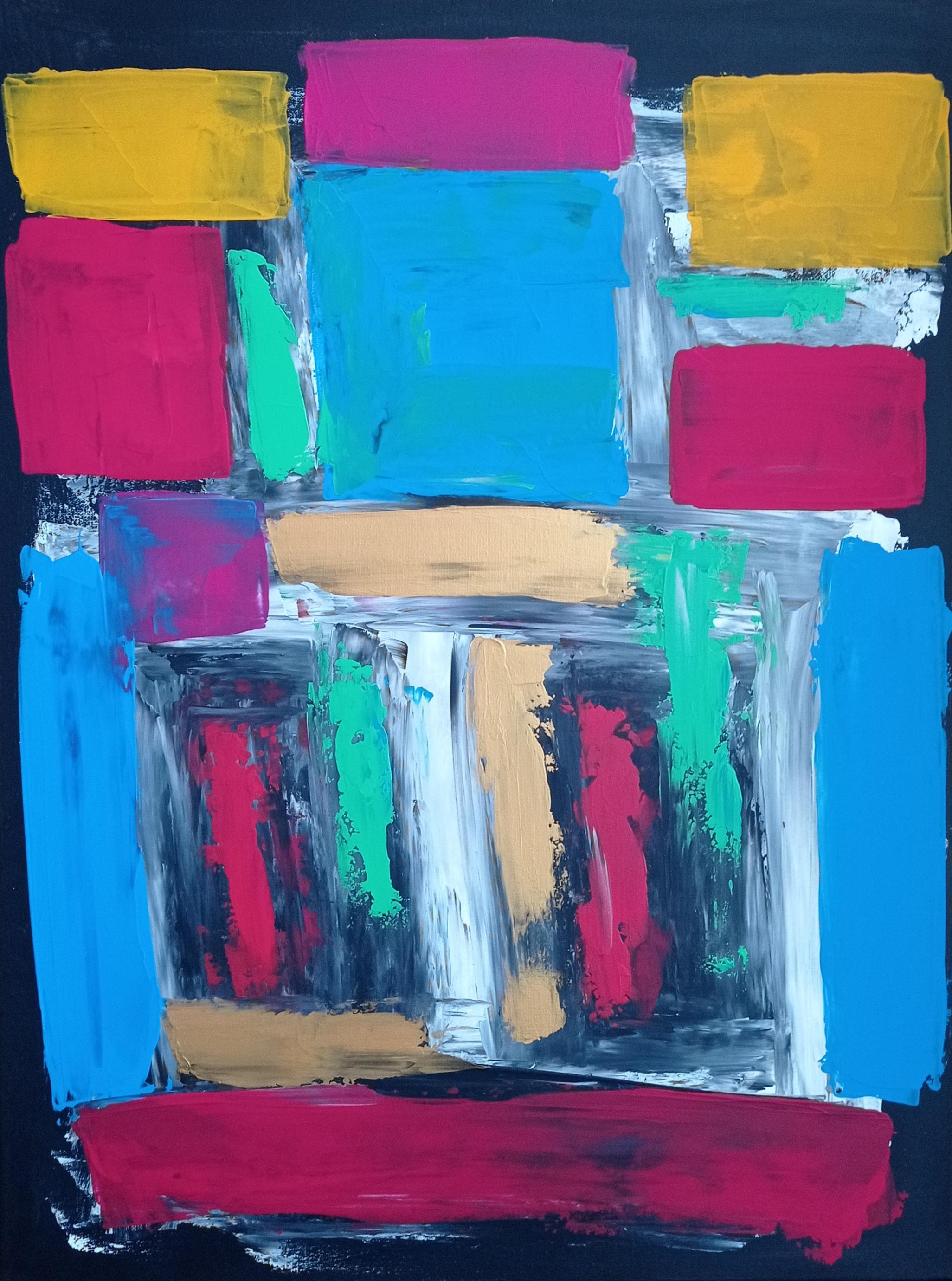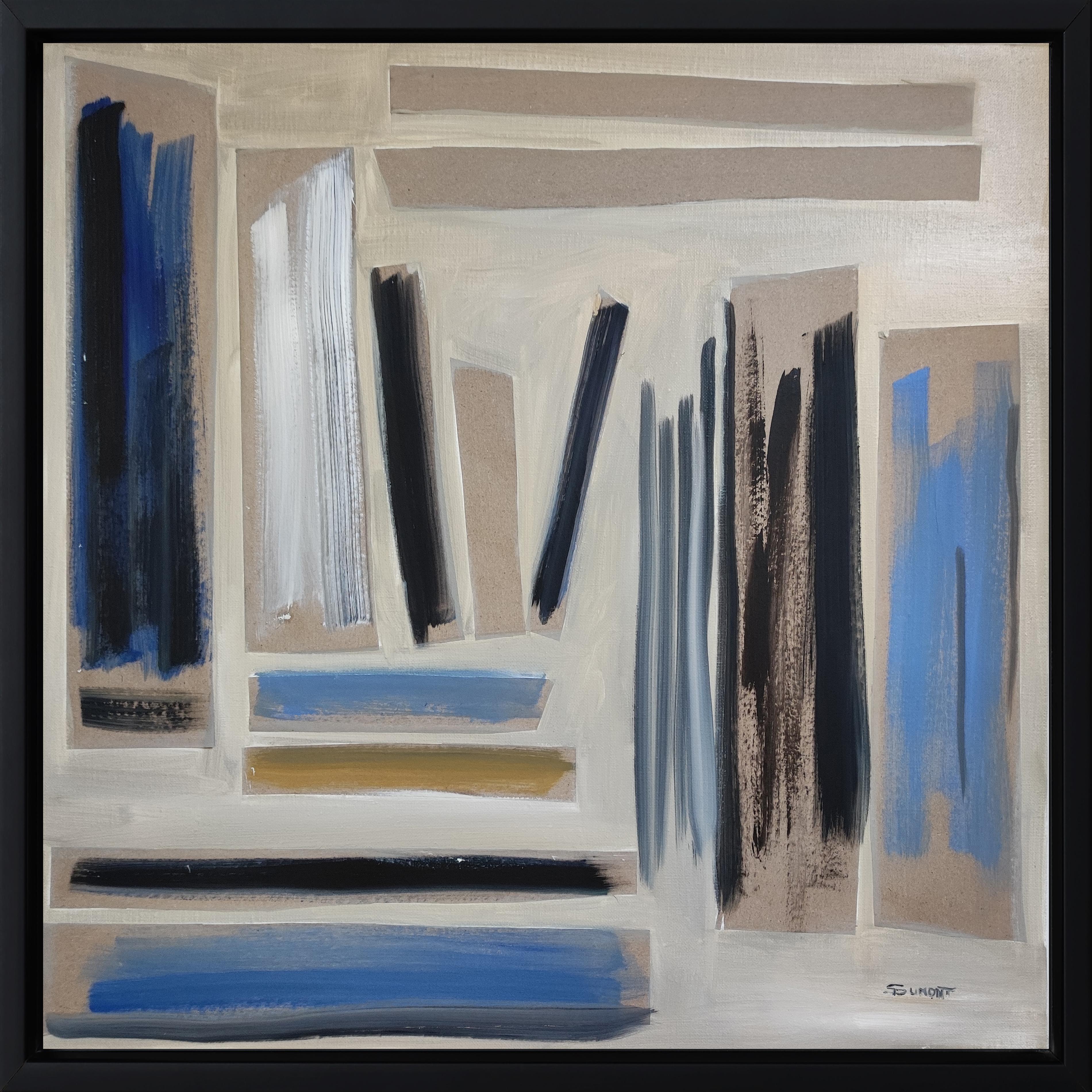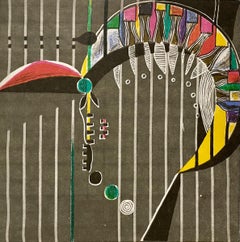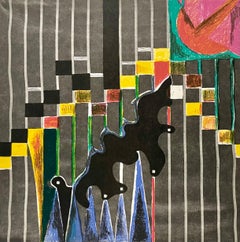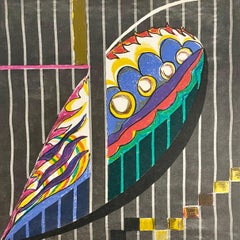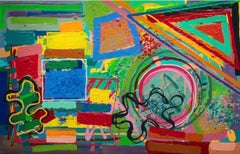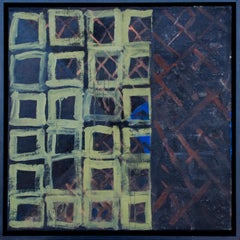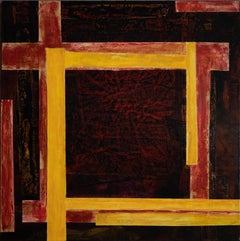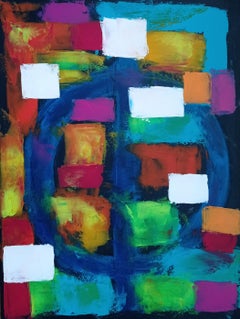Items Similar to Feminist Surrealist French Abstract Apres Mondrian Oil Painting Myriam Bat Yosef
Want more images or videos?
Request additional images or videos from the seller
1 of 16
Myriam Bat YosefFeminist Surrealist French Abstract Apres Mondrian Oil Painting Myriam Bat Yosef1984
1984
$4,500
£3,437.56
€3,949.75
CA$6,434.03
A$7,088.81
CHF 3,669.59
MX$85,351.05
NOK 46,465.95
SEK 43,651.82
DKK 29,489.83
About the Item
Myriam Bat-Yosef
Surrealist abstract oil painting in colorful abstract patterned rectangles and shades
Hand signed and dated 1984.
Miniature design letter also signed.
Myriam Bat-Yosef, whose real name is Marion Hellerman, born on January 31, 1931 in Berlin, Germany to a Jewish family from Lithuania, she is an Israeli-Icelandic artist who paints on papers, paintings, fabrics, objects and human beings for performances. Myriam Bat-Yosef currently lives and works in Paris. In 1933, her family fleeing the Nazi Holocaust, Miriam Bat-Yosef emigrates to Palestine and settles in Jaffa. In 1936, she suffers a family tragedy, her father, militant Zionist, is called to fight, still recovering from an operation of appendicitis. The incision will become infected, antibiotics did not exist yet, and her father will die in the hospital after 9 months of suffering.
Myriam and her mother leave Palestine to live in Paris for three years. French is Myriam's first school language. In 1939, still fleeing Nazism, she returned to Palestine, leaving France by the last boat from Marseille. She moved to Tel Aviv with her mother, aunt and maternal grandmother.
In 1940, she began attending the Academy of Fine Arts in Tel Aviv and took her name as an artist, Bat-Yosef, which means Joseph's daughter in Hebrew, as a tribute to her father. In 1946, Myriam graduated as a kindergarten teacher but wanted to be an artist. Her mother enrolled her in an evening school to prepare a diploma of art teacher. At 19, she performs two years of military service in Israel.
In 1952, with a pension of $50 a month that her mother allocated, she went to study at the Beaux-Arts in Paris. To survive, she has several activities while studying. In 1955, she had her first solo exhibition, at the Israeli Club on Wagram Avenue in Paris. Many artists, such as Yaacov Agam, Yehuda Neiman Avigdor Arikha, Raffi Kaiser, Dani Karavan and sculptors Achiam and Shlomo Selinger attended the opening .
In 1956, she enrolled at the School of Fine Arts in Florence. This is where she meets the painter Errô. They share an icy studio in winter. Myriam moves to Milan with friends. She organizes a joint exhibition with Erro, one room each, at the Montenapoleone gallery. Her works are admired by the sculptor Marino Marini and the painters Renato Birolli and Enrico Prampolini. Myriam and Erro exhibit in Rome, Milan, Florence and meet many personalities: Alain Jouffroy and his wife, the painter Manina, Roberto Matta and his wife Malitte, textile artist who was one of the founders of the Pompidou Center. Back in Paris, Myriam and Erro get married, which allows Myriam to avoid being called into the Israeli army during the Suez Canal War.
In 1957, Myriam and her husband went to Iceland. Myriam works in a chocolate factory. Having enough money, she starts producing art again. She exhibited in Reykjavik's first art gallery. She meets the artist Sigridur Bjornsdottir, married to the Swiss painter Dieter Roth .
In 1958, Myriam and her husband leave for Israel. They exhibit in Germany, then in Israel. Back in Paris, the couple became friends with artists of the surrealist movement, such as Victor Brauner, Hans Bellmer, the sculptor Philippe Hiquily, Liliane Lijn, future wife of Takis and photographer Nathalie Waag. Erro and Myriam have a daughter on March 15, 1960, named Tura, after the painter Cosmè Tura, but also close to the Icelandic Thora or the Hebrew Torah. Bat-Yosef’s complex trajectory throughout the 20th century is linked as much to the transnational history of what was for a time called the School of Paris as it is to a certain legacy of Surrealism. Her work features the same idea of resolving antinomies that also defined the spirit of surrealism, and is enhanced with her readings of the Kabbalah and her spiritual grounding in Taoism. However, while there are reasons for her approach to be associated with the process of the ready-made, it is important to consider the immediate intrication of these works with her practice of performance, during which the body itself is also painted – a feminist response to Yves Klein’s Anthropometries (1960) and an echo of the happenings which Jean-Jacques Lebel organised at the time in Paris.
In 1963, Erró told Myriam that if she wants to be a painter, she can not be his wife. Myriam chose to be a painter and the couple divorced in 1964. Since that time, Myriam Bat-Yosef has exhibited in many countries: Europe, United States, Japan, etc.
Although long in the shadows, the work of Myriam Bat-Yosef has been greeted by many artists and personalities: Anaïs Nin, Nancy Huston, André Pieyre of Mandiargues, José Pierre, René de Solier , Jacques Lacarrière, Alain Bosquet, Pierre Restany, Sarane Alexandrian and Surrealist André Breton who, after a visit to her studio, confided to having been intrigued by its phantasmagorical dimension. She was included in the book Pop Art and Beyond: Gender, Race, and Class in the Global Sixties by Mona Hadler and Kalliopi Minioudaki. Extract "World Citizen, Artist of the Pop Era Sarah Wilson; Why do we know so little of Myriam Bat-Yosef, the most important female Israeli artist of the Pop era? Issues of identity and sexuality feature constantly in her work. She exhibited internationally from Reykjavik to Tokyo; she had two shows at Arturo Schwarz’s famous Dada/surrealist gallery in Milan; she participated in feminist art events in Los Angeles. Above all, in 1971, she conceived Total Art, a Pop Gesamtkunstwerk inside and outside the Israel Museum, Jerusalem. Painter, performer, and installation artist, she was also a lover, wife, and mother. Of Lithuanian-Jewish descent, she was close to the family of philosopher Emmanuel Levinas. An émigré in Paris she would repudiate a national passport, participating in Garry Davis’s short-lived “World Citizens” movement. She continues the lineage of women surrealist artists: Valentine Hugo, Leonor Fini, Dorothea Tanning, Leonora Carrington, Unica Zürn, Jane Graverol, Toyen, Alice Rahon and Frida Kahlo.
Bat-Yosef’s complex trajectory throughout the 20th century is linked as much to the transnational history of what was for a time called the School of Paris as it is to a certain legacy of Surrealism. While the artist never formally took part in the activities of André Breton’s group, which assigned women a primarily passive role by denying them any capacity for action and any inscription in the canon1, her work features the same idea of resolving antinomies that also defined the spirit of surrealism2, and is enhanced with her readings of the Kabbalah and her spiritual grounding in Taoism.
Such is the supposed opposition of art and life, which Bat-Yosef worked to make obsolete as early as 1964 by covering everyday objects in paint, late examples of which (1984-1993) can be seen in the exhibit. However, while there are reasons for her approach to be associated with the process of the ready-made3, it is important to consider the immediate intrication of these works with her practice of performance, during which the body itself is also painted – a feminist response to Yves Klein’s Anthropometries (1960) and an echo of the happenings which Jean-Jacques Lebel organised at the time in Paris, and which are not particularly noted for their emancipation of the female body4. The transition from one issue to the other is expressed through the use of a television set showing pictures of a performance next to another of her painted objects, La Tour des prières (The Tower of Prayers, 1977). Beside the object is a photograph that documents its activation through action, the presence of which prompts an additional question about its status, while its existence as an image in her works on paper informs us of its importance within the body of representations specific to the artist.
1987 - 1989 Parsons School of Design, Paris
1986 - 1989 French Institute of Fashion, Paris
1989 - 1990 WICE (Institute for Continuous Education), Paris
1986 - On request, in his workshop, and elsewhere.
Main personal exhibitions
Since 1958, Myriam Bat-Yosef has held more than 100 solo exhibitions worldwide including the main ones:
1958 Museum of Tel Aviv
1963 Reykjavik National Museum, Iceland
1964 Lucien Durand Gallery, Paris, France. Schwarz Gallery, Milan , Italy.
1965 Sydow Gallery, Frankfurt , Germany, presented by Alain Jouffroy.
1967 Aoki Gallery, Tokyo , Japan.
1969 Museum of Tel Aviv, Israel. Passepartout Gallery, Copenhagen , Denmark.
Latina Gallery, Stockholm, Sweden. Presented by Pierre Restany.
Schwarz Gallery, Milan, Italy. Presented by Franco Passoni
1970 Galerie Gmurzynska, Cologne , Germany, Presented by Pierre Restany.
1971 Israel Museum, Jerusalem , Israel. Noraena Hus Museum, Reykjavik
1995 Akureyri Museum, Iceland.
2005 Claude Samuel Gallery
2009 Claire Corcia Gallery, Paris
Main group exhibitions
1955, Salon of the Young Painting, Paris
1964, Tokyo Triennale, Japan.
1965 May Salon, Paris. Biennial of Paris
Museum of Modern Art in Rhode Island , United States
1967, Collage 67, Munich , Germany
1968, May Fair, Paris.
1972, Grafik Biennial. Vienna (Austria)
1976, World surrealist exhibition, Chicago . Organized by Franklin Rosemont
1986, Bellay Gallery, Paris; The Girls of Demeter , presented by Jacques Lacarrière.
1990, Artcurial, The Belvedere of Mandiargue, Paris
1998, Museum of Eroticism, Paris.
2001, Arturo Schwarz Collection, Israel Museum, Jerusalem
2002, Royal Academy of Arts; Paris Capital of the Arts 1900-1968, London, curator Sarah Wilson
2009, AREA, review (s) Femini Pluriel
Performances
1965 Biennial of Paris and the ORTF With François Dufrêne and Teresa Trujilo
Bilboquet Theater, with Copi, Martine Barat, Théo Lesoualch, directed by Jorge Lavelli
1981, Transmutation , by Catherine Dreyfus and Franco Contini, Paris. 22 minutes
1982, Corp Accord , with Eugénie Kuffler , Donguy Gallery, Paris
1991, Un Certain Plume , super 8 movie, of this performance, transferred to video, translated from Hebrew into French, said by Monique Rabanit. 60 minutes.
1991, Eryximaque ", created from slides, made by Myriam Bat-Yosef in 1965, with François Dufrêne and Teresa Trujilo. 8 minutes.
1992, My Testament , My Last Will , filmed in the exhibition at the Ramat-Gan Museum, by Honi Hameagel, original music by Dror Elimelech. 45 minutes.
- Creator:Myriam Bat Yosef (1931)
- Creation Year:1984
- Dimensions:Height: 19.75 in (50.17 cm)Width: 19.75 in (50.17 cm)
- Medium:
- Movement & Style:
- Period:
- Condition:Refer to photos.
- Gallery Location:Surfside, FL
- Reference Number:1stDibs: LU38214496982
About the Seller
4.9
Platinum Seller
Premium sellers with a 4.7+ rating and 24-hour response times
Established in 1995
1stDibs seller since 2014
1,817 sales on 1stDibs
Typical response time: 1 hour
- ShippingRetrieving quote...Shipping from: Surfside, FL
- Return Policy
Authenticity Guarantee
In the unlikely event there’s an issue with an item’s authenticity, contact us within 1 year for a full refund. DetailsMoney-Back Guarantee
If your item is not as described, is damaged in transit, or does not arrive, contact us within 7 days for a full refund. Details24-Hour Cancellation
You have a 24-hour grace period in which to reconsider your purchase, with no questions asked.Vetted Professional Sellers
Our world-class sellers must adhere to strict standards for service and quality, maintaining the integrity of our listings.Price-Match Guarantee
If you find that a seller listed the same item for a lower price elsewhere, we’ll match it.Trusted Global Delivery
Our best-in-class carrier network provides specialized shipping options worldwide, including custom delivery.More From This Seller
View AllFeminist Surrealist French Abstract Colorful Lithograph Print Myriam Bat Yosef
Located in Surfside, FL
Myriam Bat-Yosef
Surrealist abstract lithograph print in colorful abstract shapes and shades
Hand signed and dated 1971.
sheet measures 9.25 X 9.25 inches
The envelope and the Peter Buch poster is just for provenance and is not included in this sale.
Myriam Bat-Yosef, whose real name is Marion Hellerman, born on January 31, 1931 in Berlin, Germany to a Jewish family from Lithuania, she is an Israeli-Icelandic artist who paints on papers, paintings, fabrics, objects and human beings for performances. Myriam Bat-Yosef currently lives and works in Paris. In 1933, her family fleeing the Nazi Holocaust, Miriam Bat-Yosef emigrates to Palestine and settles in Jaffa. In 1936, she suffers a family tragedy, her father, militant Zionist, is called to fight, still recovering from an operation of appendicitis. The incision will become infected, antibiotics did not exist yet, and her father will die in the hospital after 9 months of suffering.
Myriam and her mother leave Palestine to live in Paris for three years. French is Myriam's first school language. In 1939, still fleeing Nazism, she returned to Palestine, leaving France by the last boat from Marseille. She moved to Tel Aviv with her mother, aunt and maternal grandmother.
In 1940, she began attending the Academy of Fine Arts in Tel Aviv and took her name as an artist, Bat-Yosef, which means Joseph's daughter in Hebrew, as a tribute to her father. In 1946, Myriam graduated as a kindergarten teacher but wanted to be an artist. Her mother enrolled her in an evening school to prepare a diploma of art teacher. At 19, she performs two years of military service in Israel.
In 1952, with a pension of $50 a month that her mother allocated, she went to study at the Beaux-Arts in Paris. To survive, she has several activities while studying. In 1955, she had her first solo exhibition, at the Israeli Club on Wagram Avenue in Paris. Many artists, such as Yaacov Agam, Yehuda Neiman Avigdor Arikha, Raffi Kaiser, Dani Karavan and sculptors Achiam and Shlomo Selinger attended the opening .
In 1956, she enrolled at the School of Fine Arts in Florence. This is where she meets the painter Errô. They share an icy studio in winter. Myriam moves to Milan with friends. She organizes a joint exhibition with Erro, one room each, at the Montenapoleone gallery. Her works are admired by the sculptor Marino Marini and the painters Renato Birolli and Enrico Prampolini. Myriam and Erro exhibit in Rome, Milan, Florence and meet many personalities: Alain Jouffroy and his wife, the painter Manina, Roberto Matta and his wife Malitte, textile artist who was one of the founders of the Pompidou Center. Back in Paris, Myriam and Erro get married, which allows Myriam to avoid being called into the Israeli army during the Suez Canal War.
In 1957, Myriam and her husband went to Iceland. Myriam works in a chocolate factory. Having enough money, she starts producing art again. She exhibited in Reykjavik's first art gallery. She meets the artist Sigridur Bjornsdottir, married to the Swiss painter Dieter Roth .
In 1958, Myriam and her husband leave for Israel. They exhibit in Germany, then in Israel. Back in Paris, the couple became friends with artists of the surrealist movement, such as Victor Brauner, Hans Bellmer, the sculptor Philippe Hiquily, Liliane Lijn, future wife of Takis and photographer Nathalie Waag. Erro and Myriam have a daughter on March 15, 1960, named Tura, after the painter Cosmè Tura, but also close to the Icelandic Thora or the Hebrew Torah. Bat-Yosef’s complex trajectory throughout the 20th century is linked as much to the transnational history of what was for a time called the School of Paris as it is to a certain legacy of Surrealism. Her work features the same idea of resolving antinomies that also defined the spirit of surrealism, and is enhanced with her readings of the Kabbalah and her spiritual grounding in Taoism. However, while there are reasons for her approach to be associated with the process of the ready-made, it is important to consider the immediate intrication of these works with her practice of performance, during which the body itself is also painted – a feminist response to Yves Klein’s Anthropometries (1960) and an echo of the happenings which Jean-Jacques Lebel organised at the time in Paris.
In 1963, Erró told Myriam that if she wants to be a painter, she can not be his wife. Myriam chose to be a painter and the couple divorced in 1964. Since that time, Myriam Bat-Yosef has exhibited in many countries: Europe, United States, Japan, etc.
Although long in the shadows, the work of Myriam Bat-Yosef has been greeted by many artists and personalities: Anaïs Nin, Nancy Huston, André Pieyre of Mandiargues, José Pierre, René de Solier , Jacques Lacarrière, Alain Bosquet, Pierre Restany, Sarane Alexandrian and Surrealist André Breton who, after a visit to her studio, confided to having been intrigued by its phantasmagorical dimension. She was included in the book Pop Art and Beyond: Gender, Race, and Class in the Global Sixties by Mona Hadler and Kalliopi Minioudaki. Extract "World Citizen, Artist of the Pop Era Sarah Wilson; Why do we know so little of Myriam Bat-Yosef, the most important female Israeli artist of the Pop era? Issues of identity and sexuality feature constantly in her work. She exhibited internationally from Reykjavik to Tokyo; she had two shows at Arturo Schwarz’s famous Dada/surrealist gallery in Milan; she participated in feminist art events in Los Angeles. Above all, in 1971, she conceived Total Art, a Pop Gesamtkunstwerk inside and outside the Israel Museum, Jerusalem. Painter, performer, and installation artist, she was also a lover, wife, and mother. Of Lithuanian-Jewish descent, she was close to the family of philosopher Emmanuel Levinas. An émigré in Paris she would repudiate a national passport, participating in Garry Davis’s short-lived “World Citizens” movement. She continues the lineage of women surrealist artists: Valentine Hugo, Leonor Fini, Dorothea Tanning, Leonora Carrington, Unica Zürn, Jane Graverol, Toyen, Alice Rahon...
Category
1970s Surrealist Abstract Prints
Materials
Lithograph
Feminist Surrealist French Abstract Colorful Lithograph Print Myriam Bat Yosef
Located in Surfside, FL
Myriam Bat-Yosef
Surrealist abstract lithograph print in colorful abstract shapes and shades
Hand signed and dated 1971.
sheet measures 9.25 X 9.25 inches
...
Category
1970s Surrealist Abstract Prints
Materials
Lithograph
Feminist Surrealist French Abstract Colorful Lithograph Print Myriam Bat Yosef
Located in Surfside, FL
Myriam Bat-Yosef
Surrealist abstract lithograph print in colorful abstract shapes and shades
Hand signed and dated 1971.
sheet measures 9.25 X 9.25 inches
...
Category
1970s Surrealist Abstract Prints
Materials
Lithograph
Large Mod Abstract Expressionist Modernist Edward Avedisian Color Field Painting
By Edward Avedisian
Located in Surfside, FL
Edward Avedisian (American, 1936-2007)
Abstract Large Painting
Acrylic on panel heavily textured with a 3D effect.
Dimensions: 48"h x 75"w
Circa late 1970s, early 1980s
Provenance: ...
Category
1970s Abstract Expressionist Abstract Paintings
Materials
Acrylic, Wood Panel
Large Abstract Oil Painting Miami Woman Modernist Lynne Golob Gelfman
By Lynne Golob Gelfman
Located in Surfside, FL
Signed, dated and titled verso.
Gelfman is often praised for using unconventional approaches during the creation process. This intricate mixed media piece is no exception. Her use ...
Category
1990s Contemporary Abstract Paintings
Materials
Cotton Canvas, Mixed Media, Acrylic
German American Neo Abstract Expressionist Contemporary Oil Painting Mixed Media
By Bernd Haussmann
Located in Surfside, FL
Berndt Haussmann (German / American, b. 1957)
Das Lied von der Erde,
mixed media painting on canvas
signed, titled and numbered on verso
unframed
32 1/4 x 48 inches.
BERND HAUSSMAN...
Category
Early 2000s Neo-Expressionist Abstract Paintings
Materials
Mixed Media, Oil
You May Also Like
Geometric Painting by Martha Lloyd, Carrie Haddad Gallery Provenance
Located in New York, NY
Martha Lloyd (American, 1927-2018)
Thaw, 1997
Oil and wax (encaustic) on canvas
20 x 20 in.
Framed: 21 1/4 x 21 1/4 x 1 3/4 in.
Inscribed verso
Provenance:
Carrie Haddad Gallery, Hudson, NY
Martha Anne Lloyd...
Category
1990s Abstract Geometric Abstract Paintings
Materials
Canvas, Encaustic, Oil
Minimalist Cubist Abstract, Signed Oil Painting by Female Artist Miriam Bromberg
By Miriam Bromberg
Located in Long Island City, NY
Minimalist Cubist Abstract
Miriam Bromberg
Oil on Canvas, signed
Size: 42 x 18 in. (106.68 x 45.72 cm)
Frame Size: 47 x 22.5 inches
Category
1970s Abstract Portrait Paintings
Materials
Oil
French Contemporary Abstract Art by J.-L. Veret - La Porte Jaune
By Jean-Luc Veret
Located in Paris, IDF
Acrylic & marouflaged paper mounted on canvas
Jean-Luc Veret is a French artist born in 1953 who lives & works between Paris & Corancy, France. He recognizes himself as a protean ar...
Category
2010s Abstract Abstract Paintings
Materials
Acrylic, Handmade Paper
Contemporary abstract expressionist painting with forms and squares "Connection"
Located in VÉNISSIEUX, FR
I have worked on a new collection of abstract paintings.This new abstract series is dedicated to a "heart- mind connection".
This is the one of them called "Connection".
While work...
Category
2010s Abstract Geometric Abstract Paintings
Materials
Acrylic, Canvas
Contemporary abstract expressionist painting with forms and squares "Intensity"
Located in VÉNISSIEUX, FR
My abstract acrylic artwork "Intensity" isn't about geometric forms which you see ( squares and rectangles). This artwork is dedicated to a "heart- mind connection".
Here my idea o...
Category
2010s Contemporary Abstract Paintings
Materials
Acrylic, Canvas
Mixed Media Abstract Painting on Linen, Geometric Neutral Composition, 2024
By SOPHIE DUMONT
Located in LANGRUNE-SUR-MER, FR
Dimensions (unframed): 60 x 60 x 2 cm (23.62 x 23.62 x 0.79 in)
Framed dimensions: 67 x 67 x 3.5 cm (26.38 x 26.38 x 1.38 in)
This original mixed media work by Sophie Dumont, a Fren...
Category
21st Century and Contemporary Abstract Geometric Abstract Paintings
Materials
Oil, Canvas
More Ways To Browse
After 50 Years Of Surrealism
Abstract Swedish Oil Painting 1960s
Mondrian Art
Icelandic Artists
Vintage Television Sets
Lucien Durand
Used Rene Pierre
Vintage Bat Art
Bates Oil Painting
Unica Zurn
Valentine Hugo
Alice Rahon
Miriam Bat Yosef
Jane Graverol
Grey Minimalist Painting
Hitchens Ivon
Jack Goldstein
John A Colby And Sons
